Comprehensive Report: Nuclear Power Development in The United States
VerifiedAdded on 2021/06/16
|19
|5921
|149
Report
AI Summary
This report provides a comprehensive overview of nuclear power development in the United States. It begins with an executive summary and an introduction that highlights the historical context and the current global emphasis on low-carbon energy sources. The report then explores the current state of nuclear technology, discussing global and US perspectives, including the types of reactors used. It examines the impact of nuclear power on the energy system, comparing it to other fuels and highlighting the energy mix. The report further delves into technical developments, including reactor technology and transmission infrastructure, and discusses future reactor designs. It also identifies both opportunities and barriers to nuclear power development, such as regulatory hurdles and cost concerns, and concludes with a personal view and final conclusions, providing references to support the findings. The report emphasizes the US's role as a pioneer in nuclear technology and its potential to meet the growing energy demands while reducing carbon emissions. The analysis covers the evolution of nuclear power, its technological advancements, and the challenges it faces in becoming market-competitive.
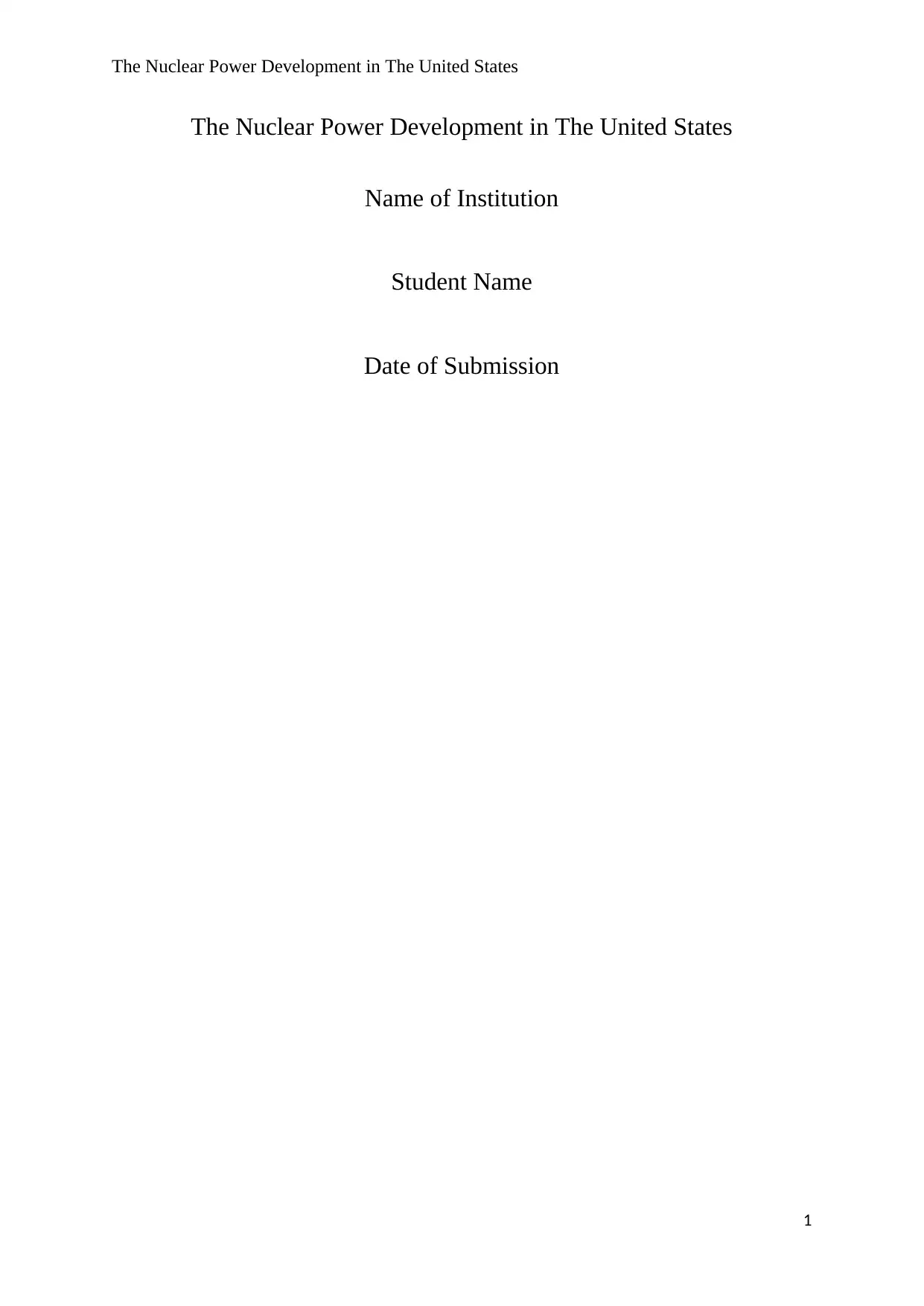
The Nuclear Power Development in The United States
The Nuclear Power Development in The United States
Name of Institution
Student Name
Date of Submission
1
The Nuclear Power Development in The United States
Name of Institution
Student Name
Date of Submission
1
Paraphrase This Document
Need a fresh take? Get an instant paraphrase of this document with our AI Paraphraser
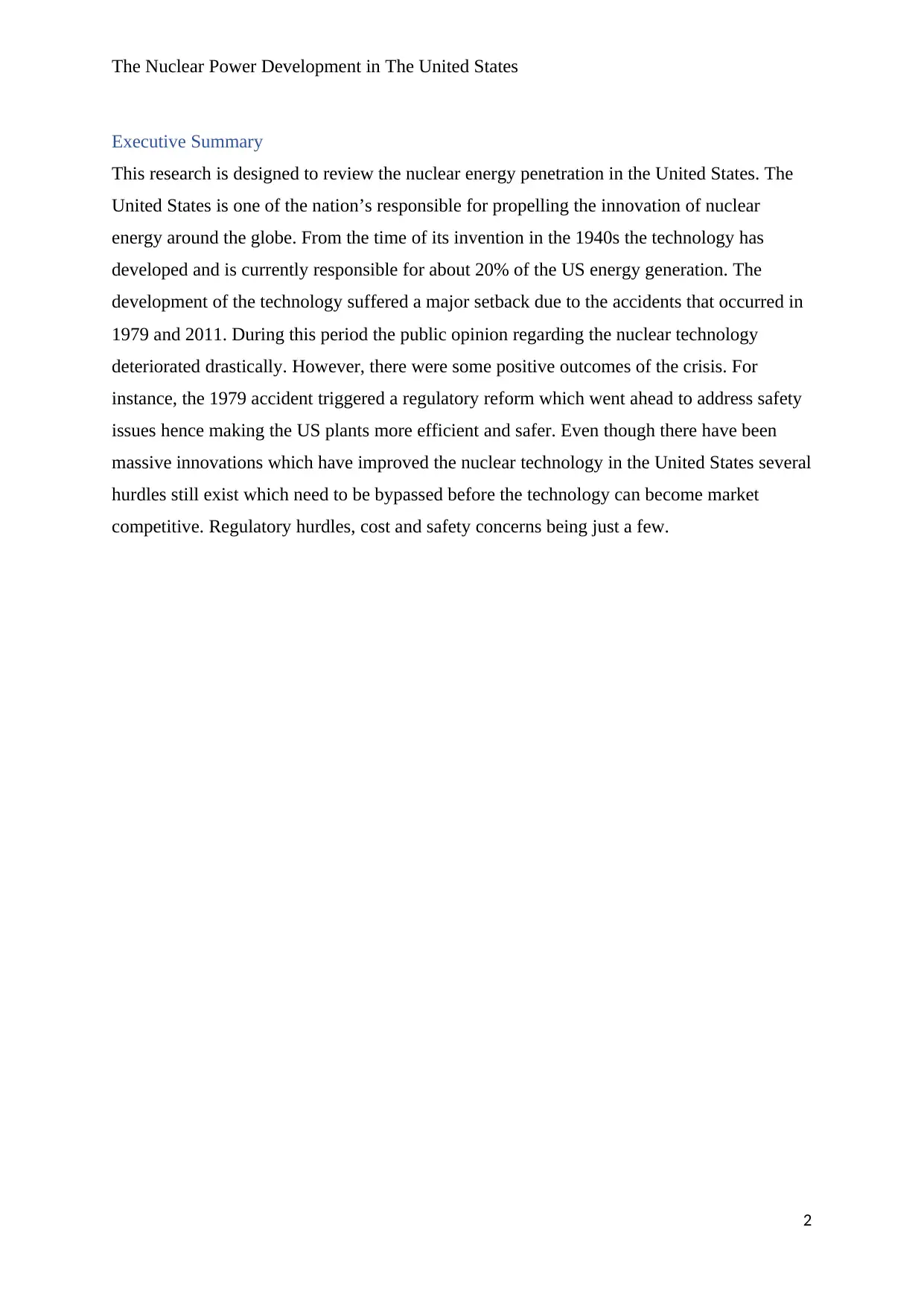
The Nuclear Power Development in The United States
Executive Summary
This research is designed to review the nuclear energy penetration in the United States. The
United States is one of the nation’s responsible for propelling the innovation of nuclear
energy around the globe. From the time of its invention in the 1940s the technology has
developed and is currently responsible for about 20% of the US energy generation. The
development of the technology suffered a major setback due to the accidents that occurred in
1979 and 2011. During this period the public opinion regarding the nuclear technology
deteriorated drastically. However, there were some positive outcomes of the crisis. For
instance, the 1979 accident triggered a regulatory reform which went ahead to address safety
issues hence making the US plants more efficient and safer. Even though there have been
massive innovations which have improved the nuclear technology in the United States several
hurdles still exist which need to be bypassed before the technology can become market
competitive. Regulatory hurdles, cost and safety concerns being just a few.
2
Executive Summary
This research is designed to review the nuclear energy penetration in the United States. The
United States is one of the nation’s responsible for propelling the innovation of nuclear
energy around the globe. From the time of its invention in the 1940s the technology has
developed and is currently responsible for about 20% of the US energy generation. The
development of the technology suffered a major setback due to the accidents that occurred in
1979 and 2011. During this period the public opinion regarding the nuclear technology
deteriorated drastically. However, there were some positive outcomes of the crisis. For
instance, the 1979 accident triggered a regulatory reform which went ahead to address safety
issues hence making the US plants more efficient and safer. Even though there have been
massive innovations which have improved the nuclear technology in the United States several
hurdles still exist which need to be bypassed before the technology can become market
competitive. Regulatory hurdles, cost and safety concerns being just a few.
2
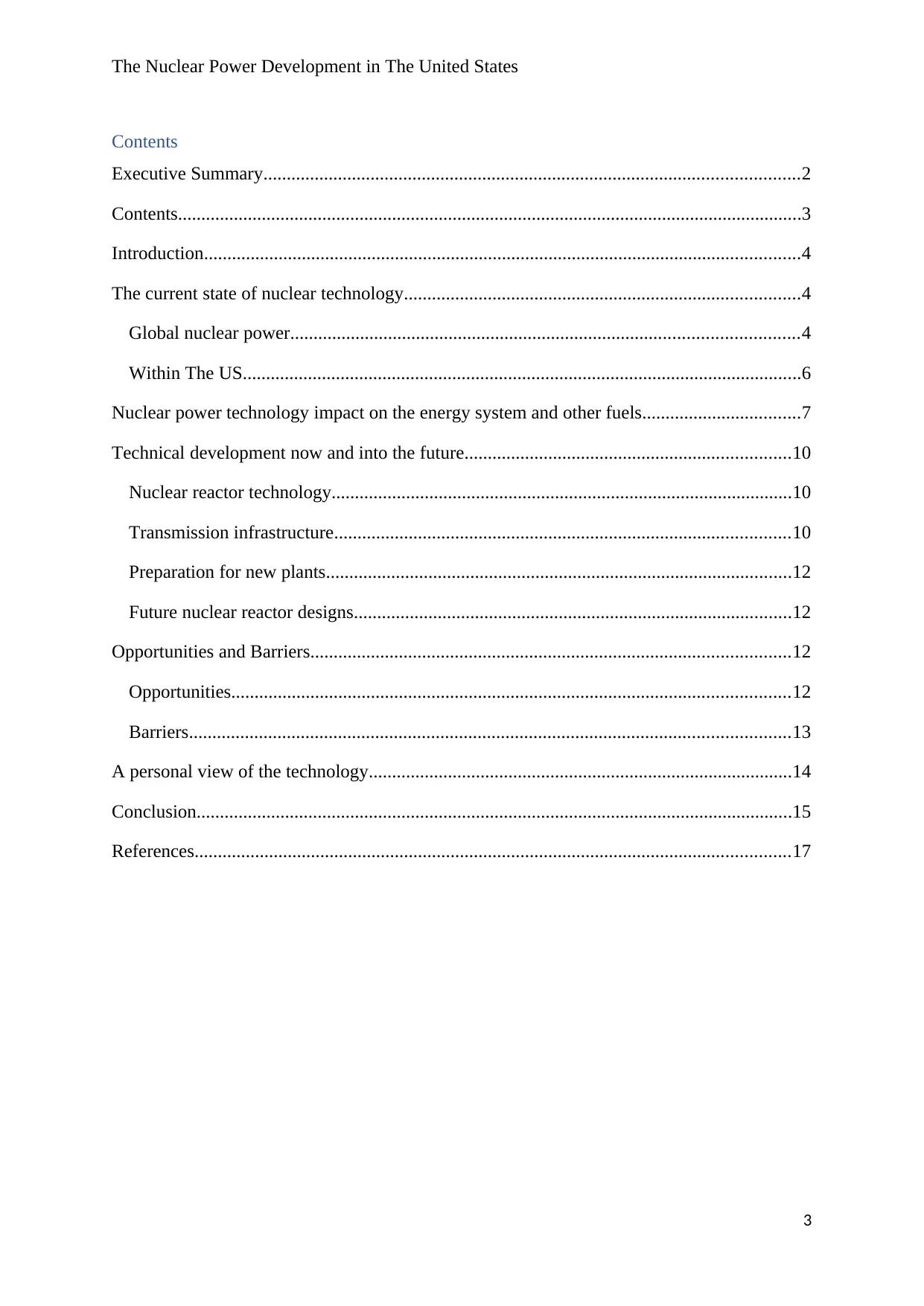
The Nuclear Power Development in The United States
Contents
Executive Summary...................................................................................................................2
Contents......................................................................................................................................3
Introduction................................................................................................................................4
The current state of nuclear technology.....................................................................................4
Global nuclear power.............................................................................................................4
Within The US........................................................................................................................6
Nuclear power technology impact on the energy system and other fuels..................................7
Technical development now and into the future......................................................................10
Nuclear reactor technology...................................................................................................10
Transmission infrastructure..................................................................................................10
Preparation for new plants....................................................................................................12
Future nuclear reactor designs..............................................................................................12
Opportunities and Barriers.......................................................................................................12
Opportunities........................................................................................................................12
Barriers.................................................................................................................................13
A personal view of the technology...........................................................................................14
Conclusion................................................................................................................................15
References................................................................................................................................17
3
Contents
Executive Summary...................................................................................................................2
Contents......................................................................................................................................3
Introduction................................................................................................................................4
The current state of nuclear technology.....................................................................................4
Global nuclear power.............................................................................................................4
Within The US........................................................................................................................6
Nuclear power technology impact on the energy system and other fuels..................................7
Technical development now and into the future......................................................................10
Nuclear reactor technology...................................................................................................10
Transmission infrastructure..................................................................................................10
Preparation for new plants....................................................................................................12
Future nuclear reactor designs..............................................................................................12
Opportunities and Barriers.......................................................................................................12
Opportunities........................................................................................................................12
Barriers.................................................................................................................................13
A personal view of the technology...........................................................................................14
Conclusion................................................................................................................................15
References................................................................................................................................17
3
⊘ This is a preview!⊘
Do you want full access?
Subscribe today to unlock all pages.

Trusted by 1+ million students worldwide
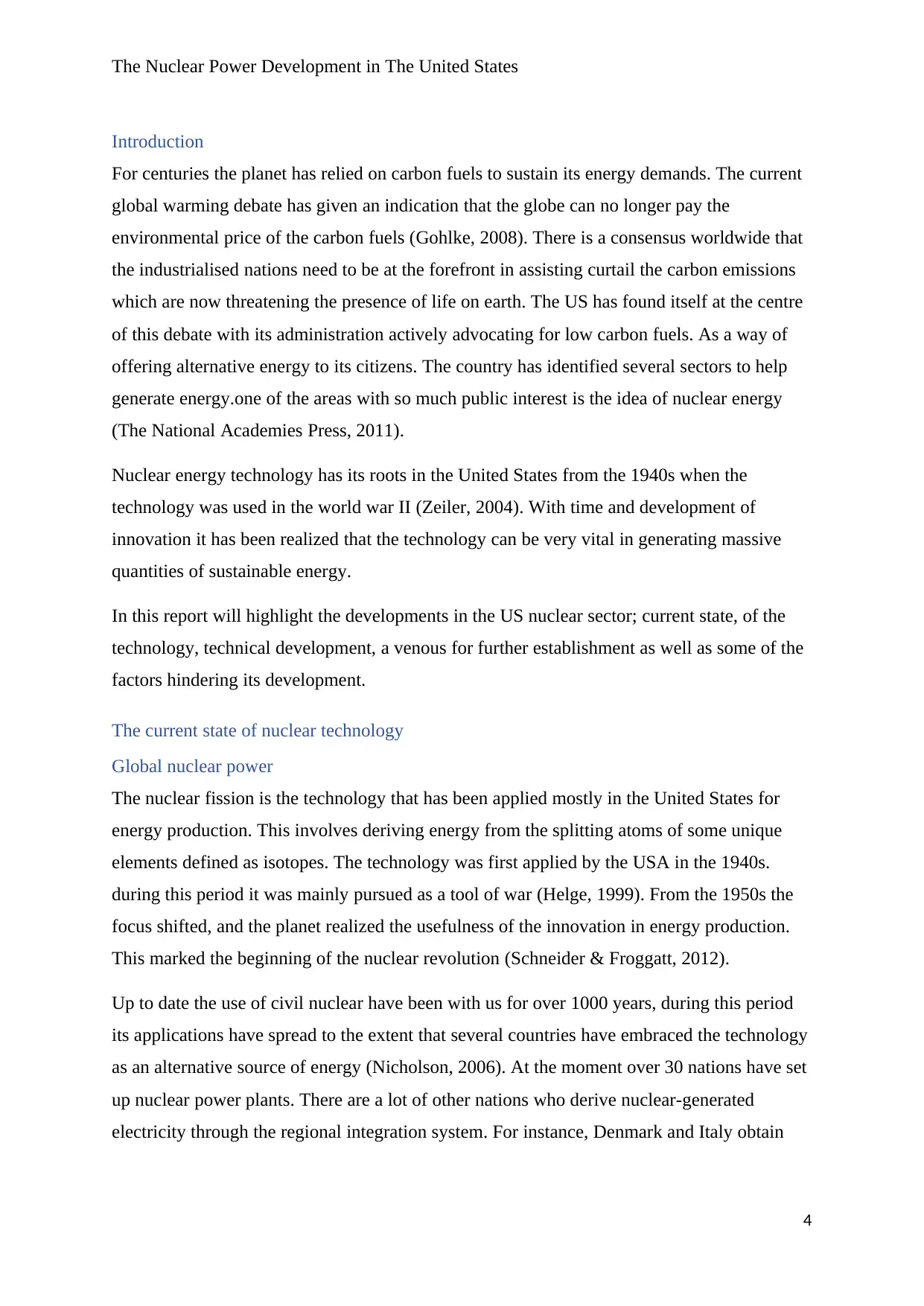
The Nuclear Power Development in The United States
Introduction
For centuries the planet has relied on carbon fuels to sustain its energy demands. The current
global warming debate has given an indication that the globe can no longer pay the
environmental price of the carbon fuels (Gohlke, 2008). There is a consensus worldwide that
the industrialised nations need to be at the forefront in assisting curtail the carbon emissions
which are now threatening the presence of life on earth. The US has found itself at the centre
of this debate with its administration actively advocating for low carbon fuels. As a way of
offering alternative energy to its citizens. The country has identified several sectors to help
generate energy.one of the areas with so much public interest is the idea of nuclear energy
(The National Academies Press, 2011).
Nuclear energy technology has its roots in the United States from the 1940s when the
technology was used in the world war II (Zeiler, 2004). With time and development of
innovation it has been realized that the technology can be very vital in generating massive
quantities of sustainable energy.
In this report will highlight the developments in the US nuclear sector; current state, of the
technology, technical development, a venous for further establishment as well as some of the
factors hindering its development.
The current state of nuclear technology
Global nuclear power
The nuclear fission is the technology that has been applied mostly in the United States for
energy production. This involves deriving energy from the splitting atoms of some unique
elements defined as isotopes. The technology was first applied by the USA in the 1940s.
during this period it was mainly pursued as a tool of war (Helge, 1999). From the 1950s the
focus shifted, and the planet realized the usefulness of the innovation in energy production.
This marked the beginning of the nuclear revolution (Schneider & Froggatt, 2012).
Up to date the use of civil nuclear have been with us for over 1000 years, during this period
its applications have spread to the extent that several countries have embraced the technology
as an alternative source of energy (Nicholson, 2006). At the moment over 30 nations have set
up nuclear power plants. There are a lot of other nations who derive nuclear-generated
electricity through the regional integration system. For instance, Denmark and Italy obtain
4
Introduction
For centuries the planet has relied on carbon fuels to sustain its energy demands. The current
global warming debate has given an indication that the globe can no longer pay the
environmental price of the carbon fuels (Gohlke, 2008). There is a consensus worldwide that
the industrialised nations need to be at the forefront in assisting curtail the carbon emissions
which are now threatening the presence of life on earth. The US has found itself at the centre
of this debate with its administration actively advocating for low carbon fuels. As a way of
offering alternative energy to its citizens. The country has identified several sectors to help
generate energy.one of the areas with so much public interest is the idea of nuclear energy
(The National Academies Press, 2011).
Nuclear energy technology has its roots in the United States from the 1940s when the
technology was used in the world war II (Zeiler, 2004). With time and development of
innovation it has been realized that the technology can be very vital in generating massive
quantities of sustainable energy.
In this report will highlight the developments in the US nuclear sector; current state, of the
technology, technical development, a venous for further establishment as well as some of the
factors hindering its development.
The current state of nuclear technology
Global nuclear power
The nuclear fission is the technology that has been applied mostly in the United States for
energy production. This involves deriving energy from the splitting atoms of some unique
elements defined as isotopes. The technology was first applied by the USA in the 1940s.
during this period it was mainly pursued as a tool of war (Helge, 1999). From the 1950s the
focus shifted, and the planet realized the usefulness of the innovation in energy production.
This marked the beginning of the nuclear revolution (Schneider & Froggatt, 2012).
Up to date the use of civil nuclear have been with us for over 1000 years, during this period
its applications have spread to the extent that several countries have embraced the technology
as an alternative source of energy (Nicholson, 2006). At the moment over 30 nations have set
up nuclear power plants. There are a lot of other nations who derive nuclear-generated
electricity through the regional integration system. For instance, Denmark and Italy obtain
4
Paraphrase This Document
Need a fresh take? Get an instant paraphrase of this document with our AI Paraphraser
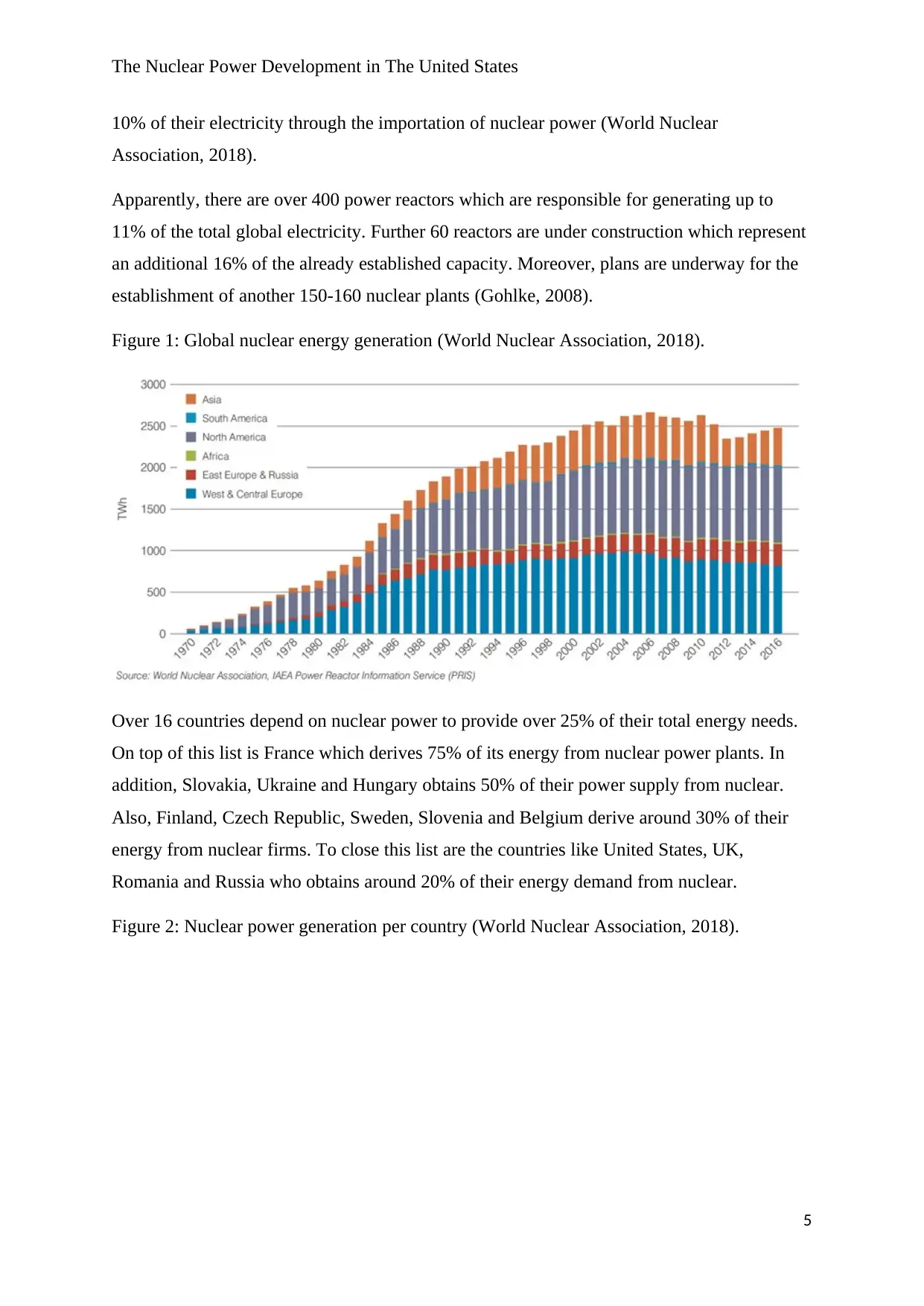
The Nuclear Power Development in The United States
10% of their electricity through the importation of nuclear power (World Nuclear
Association, 2018).
Apparently, there are over 400 power reactors which are responsible for generating up to
11% of the total global electricity. Further 60 reactors are under construction which represent
an additional 16% of the already established capacity. Moreover, plans are underway for the
establishment of another 150-160 nuclear plants (Gohlke, 2008).
Figure 1: Global nuclear energy generation (World Nuclear Association, 2018).
Over 16 countries depend on nuclear power to provide over 25% of their total energy needs.
On top of this list is France which derives 75% of its energy from nuclear power plants. In
addition, Slovakia, Ukraine and Hungary obtains 50% of their power supply from nuclear.
Also, Finland, Czech Republic, Sweden, Slovenia and Belgium derive around 30% of their
energy from nuclear firms. To close this list are the countries like United States, UK,
Romania and Russia who obtains around 20% of their energy demand from nuclear.
Figure 2: Nuclear power generation per country (World Nuclear Association, 2018).
5
10% of their electricity through the importation of nuclear power (World Nuclear
Association, 2018).
Apparently, there are over 400 power reactors which are responsible for generating up to
11% of the total global electricity. Further 60 reactors are under construction which represent
an additional 16% of the already established capacity. Moreover, plans are underway for the
establishment of another 150-160 nuclear plants (Gohlke, 2008).
Figure 1: Global nuclear energy generation (World Nuclear Association, 2018).
Over 16 countries depend on nuclear power to provide over 25% of their total energy needs.
On top of this list is France which derives 75% of its energy from nuclear power plants. In
addition, Slovakia, Ukraine and Hungary obtains 50% of their power supply from nuclear.
Also, Finland, Czech Republic, Sweden, Slovenia and Belgium derive around 30% of their
energy from nuclear firms. To close this list are the countries like United States, UK,
Romania and Russia who obtains around 20% of their energy demand from nuclear.
Figure 2: Nuclear power generation per country (World Nuclear Association, 2018).
5
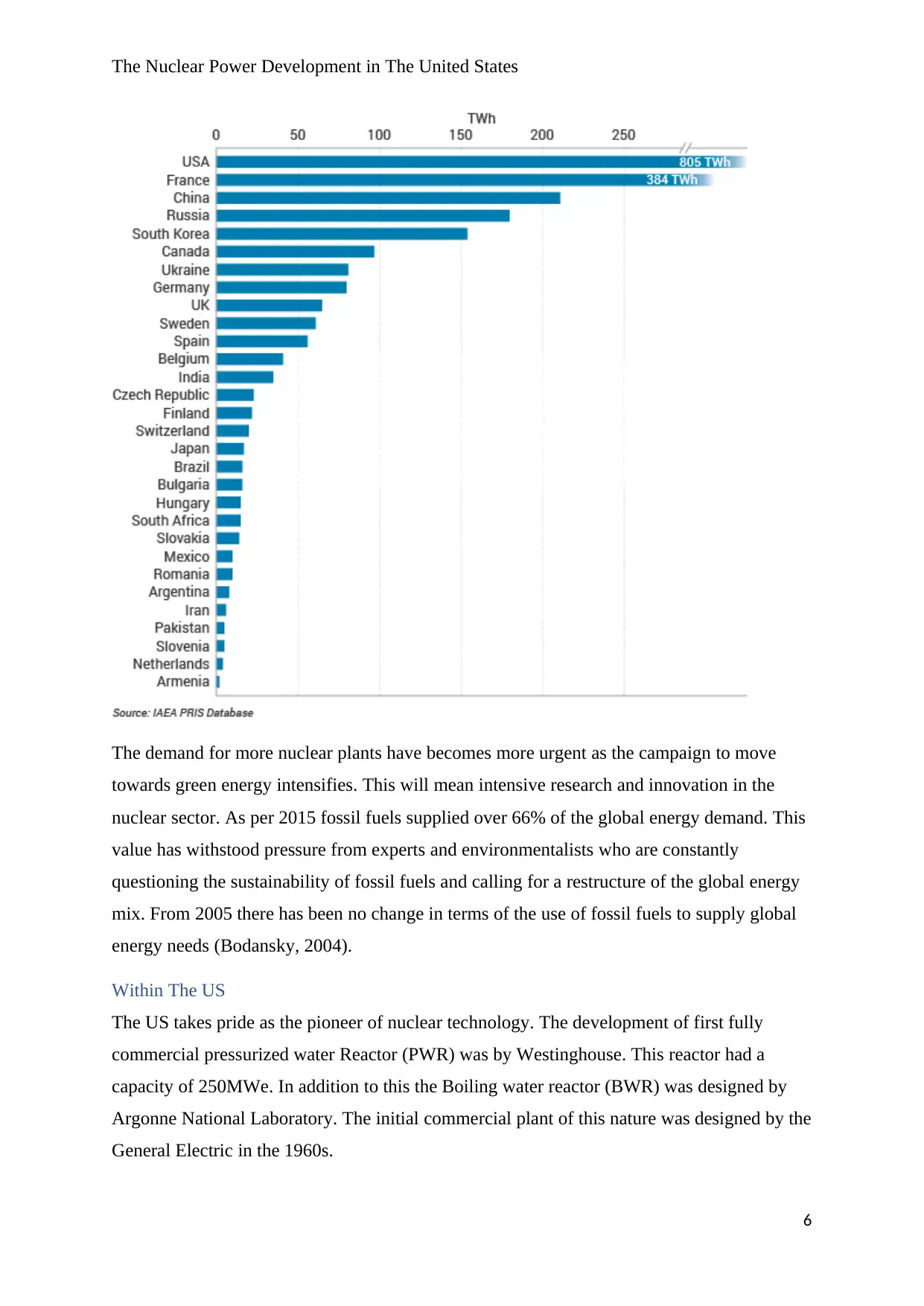
The Nuclear Power Development in The United States
The demand for more nuclear plants have becomes more urgent as the campaign to move
towards green energy intensifies. This will mean intensive research and innovation in the
nuclear sector. As per 2015 fossil fuels supplied over 66% of the global energy demand. This
value has withstood pressure from experts and environmentalists who are constantly
questioning the sustainability of fossil fuels and calling for a restructure of the global energy
mix. From 2005 there has been no change in terms of the use of fossil fuels to supply global
energy needs (Bodansky, 2004).
Within The US
The US takes pride as the pioneer of nuclear technology. The development of first fully
commercial pressurized water Reactor (PWR) was by Westinghouse. This reactor had a
capacity of 250MWe. In addition to this the Boiling water reactor (BWR) was designed by
Argonne National Laboratory. The initial commercial plant of this nature was designed by the
General Electric in the 1960s.
6
The demand for more nuclear plants have becomes more urgent as the campaign to move
towards green energy intensifies. This will mean intensive research and innovation in the
nuclear sector. As per 2015 fossil fuels supplied over 66% of the global energy demand. This
value has withstood pressure from experts and environmentalists who are constantly
questioning the sustainability of fossil fuels and calling for a restructure of the global energy
mix. From 2005 there has been no change in terms of the use of fossil fuels to supply global
energy needs (Bodansky, 2004).
Within The US
The US takes pride as the pioneer of nuclear technology. The development of first fully
commercial pressurized water Reactor (PWR) was by Westinghouse. This reactor had a
capacity of 250MWe. In addition to this the Boiling water reactor (BWR) was designed by
Argonne National Laboratory. The initial commercial plant of this nature was designed by the
General Electric in the 1960s.
6
⊘ This is a preview!⊘
Do you want full access?
Subscribe today to unlock all pages.

Trusted by 1+ million students worldwide
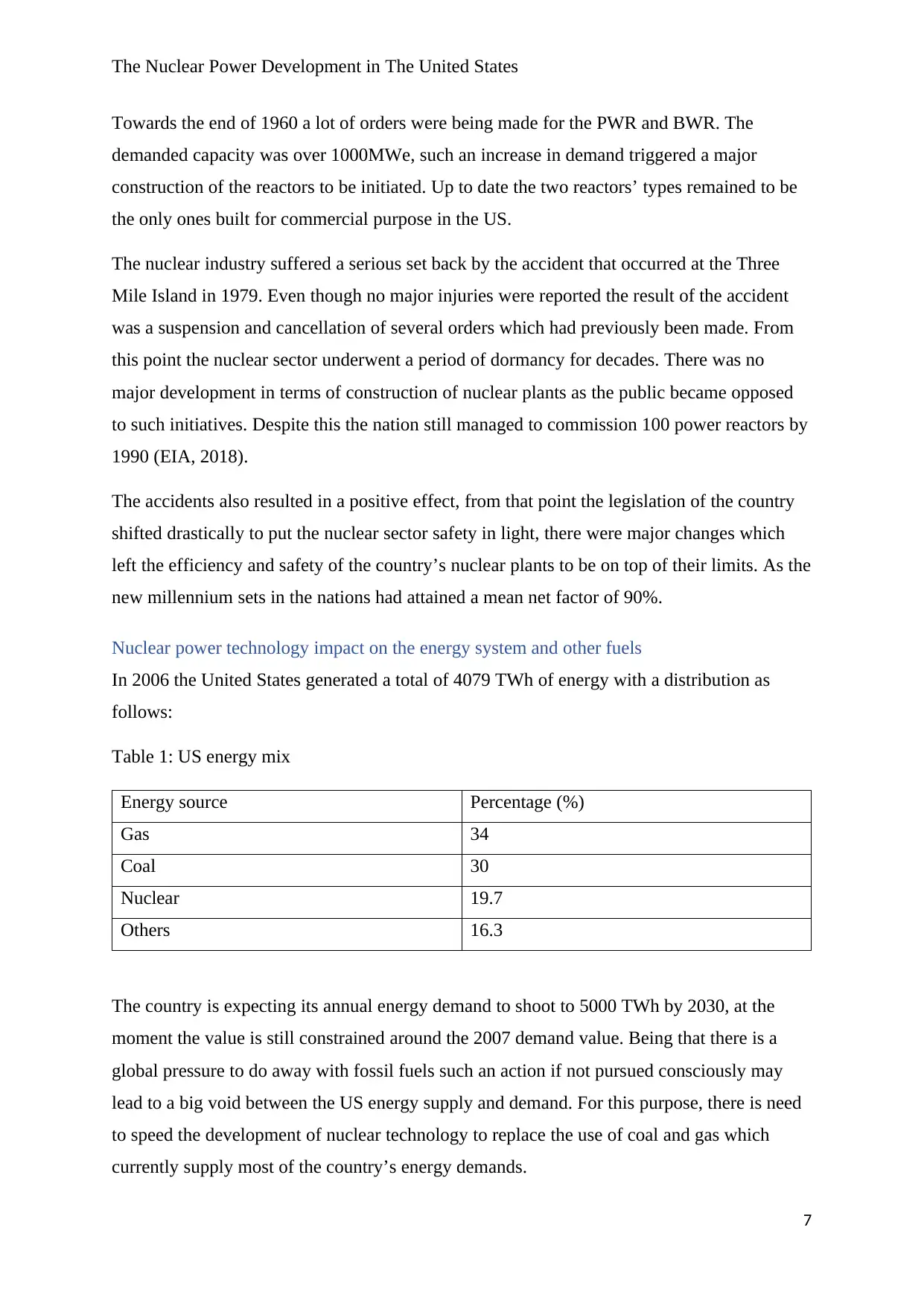
The Nuclear Power Development in The United States
Towards the end of 1960 a lot of orders were being made for the PWR and BWR. The
demanded capacity was over 1000MWe, such an increase in demand triggered a major
construction of the reactors to be initiated. Up to date the two reactors’ types remained to be
the only ones built for commercial purpose in the US.
The nuclear industry suffered a serious set back by the accident that occurred at the Three
Mile Island in 1979. Even though no major injuries were reported the result of the accident
was a suspension and cancellation of several orders which had previously been made. From
this point the nuclear sector underwent a period of dormancy for decades. There was no
major development in terms of construction of nuclear plants as the public became opposed
to such initiatives. Despite this the nation still managed to commission 100 power reactors by
1990 (EIA, 2018).
The accidents also resulted in a positive effect, from that point the legislation of the country
shifted drastically to put the nuclear sector safety in light, there were major changes which
left the efficiency and safety of the country’s nuclear plants to be on top of their limits. As the
new millennium sets in the nations had attained a mean net factor of 90%.
Nuclear power technology impact on the energy system and other fuels
In 2006 the United States generated a total of 4079 TWh of energy with a distribution as
follows:
Table 1: US energy mix
Energy source Percentage (%)
Gas 34
Coal 30
Nuclear 19.7
Others 16.3
The country is expecting its annual energy demand to shoot to 5000 TWh by 2030, at the
moment the value is still constrained around the 2007 demand value. Being that there is a
global pressure to do away with fossil fuels such an action if not pursued consciously may
lead to a big void between the US energy supply and demand. For this purpose, there is need
to speed the development of nuclear technology to replace the use of coal and gas which
currently supply most of the country’s energy demands.
7
Towards the end of 1960 a lot of orders were being made for the PWR and BWR. The
demanded capacity was over 1000MWe, such an increase in demand triggered a major
construction of the reactors to be initiated. Up to date the two reactors’ types remained to be
the only ones built for commercial purpose in the US.
The nuclear industry suffered a serious set back by the accident that occurred at the Three
Mile Island in 1979. Even though no major injuries were reported the result of the accident
was a suspension and cancellation of several orders which had previously been made. From
this point the nuclear sector underwent a period of dormancy for decades. There was no
major development in terms of construction of nuclear plants as the public became opposed
to such initiatives. Despite this the nation still managed to commission 100 power reactors by
1990 (EIA, 2018).
The accidents also resulted in a positive effect, from that point the legislation of the country
shifted drastically to put the nuclear sector safety in light, there were major changes which
left the efficiency and safety of the country’s nuclear plants to be on top of their limits. As the
new millennium sets in the nations had attained a mean net factor of 90%.
Nuclear power technology impact on the energy system and other fuels
In 2006 the United States generated a total of 4079 TWh of energy with a distribution as
follows:
Table 1: US energy mix
Energy source Percentage (%)
Gas 34
Coal 30
Nuclear 19.7
Others 16.3
The country is expecting its annual energy demand to shoot to 5000 TWh by 2030, at the
moment the value is still constrained around the 2007 demand value. Being that there is a
global pressure to do away with fossil fuels such an action if not pursued consciously may
lead to a big void between the US energy supply and demand. For this purpose, there is need
to speed the development of nuclear technology to replace the use of coal and gas which
currently supply most of the country’s energy demands.
7
Paraphrase This Document
Need a fresh take? Get an instant paraphrase of this document with our AI Paraphraser
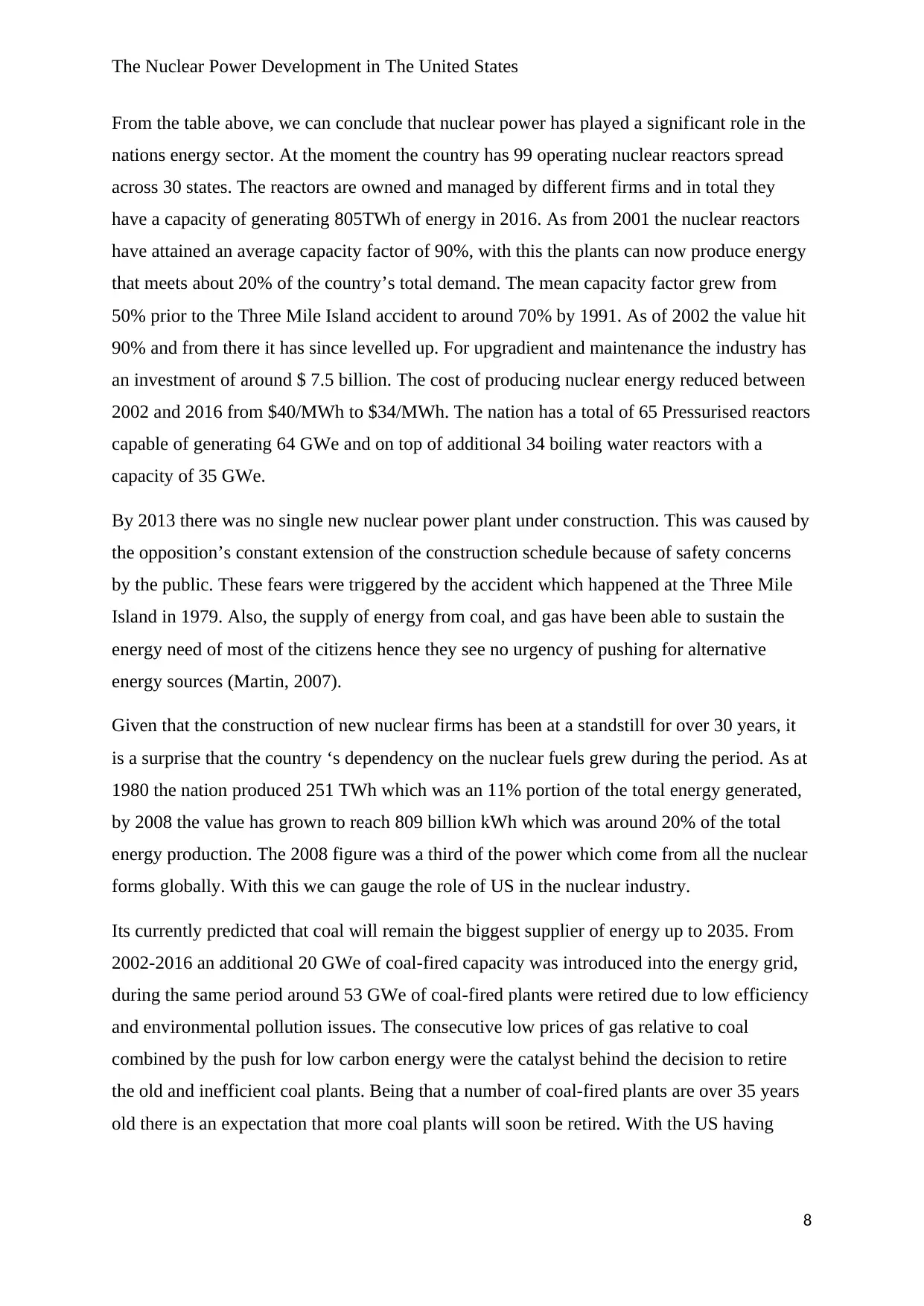
The Nuclear Power Development in The United States
From the table above, we can conclude that nuclear power has played a significant role in the
nations energy sector. At the moment the country has 99 operating nuclear reactors spread
across 30 states. The reactors are owned and managed by different firms and in total they
have a capacity of generating 805TWh of energy in 2016. As from 2001 the nuclear reactors
have attained an average capacity factor of 90%, with this the plants can now produce energy
that meets about 20% of the country’s total demand. The mean capacity factor grew from
50% prior to the Three Mile Island accident to around 70% by 1991. As of 2002 the value hit
90% and from there it has since levelled up. For upgradient and maintenance the industry has
an investment of around $ 7.5 billion. The cost of producing nuclear energy reduced between
2002 and 2016 from $40/MWh to $34/MWh. The nation has a total of 65 Pressurised reactors
capable of generating 64 GWe and on top of additional 34 boiling water reactors with a
capacity of 35 GWe.
By 2013 there was no single new nuclear power plant under construction. This was caused by
the opposition’s constant extension of the construction schedule because of safety concerns
by the public. These fears were triggered by the accident which happened at the Three Mile
Island in 1979. Also, the supply of energy from coal, and gas have been able to sustain the
energy need of most of the citizens hence they see no urgency of pushing for alternative
energy sources (Martin, 2007).
Given that the construction of new nuclear firms has been at a standstill for over 30 years, it
is a surprise that the country ‘s dependency on the nuclear fuels grew during the period. As at
1980 the nation produced 251 TWh which was an 11% portion of the total energy generated,
by 2008 the value has grown to reach 809 billion kWh which was around 20% of the total
energy production. The 2008 figure was a third of the power which come from all the nuclear
forms globally. With this we can gauge the role of US in the nuclear industry.
Its currently predicted that coal will remain the biggest supplier of energy up to 2035. From
2002-2016 an additional 20 GWe of coal-fired capacity was introduced into the energy grid,
during the same period around 53 GWe of coal-fired plants were retired due to low efficiency
and environmental pollution issues. The consecutive low prices of gas relative to coal
combined by the push for low carbon energy were the catalyst behind the decision to retire
the old and inefficient coal plants. Being that a number of coal-fired plants are over 35 years
old there is an expectation that more coal plants will soon be retired. With the US having
8
From the table above, we can conclude that nuclear power has played a significant role in the
nations energy sector. At the moment the country has 99 operating nuclear reactors spread
across 30 states. The reactors are owned and managed by different firms and in total they
have a capacity of generating 805TWh of energy in 2016. As from 2001 the nuclear reactors
have attained an average capacity factor of 90%, with this the plants can now produce energy
that meets about 20% of the country’s total demand. The mean capacity factor grew from
50% prior to the Three Mile Island accident to around 70% by 1991. As of 2002 the value hit
90% and from there it has since levelled up. For upgradient and maintenance the industry has
an investment of around $ 7.5 billion. The cost of producing nuclear energy reduced between
2002 and 2016 from $40/MWh to $34/MWh. The nation has a total of 65 Pressurised reactors
capable of generating 64 GWe and on top of additional 34 boiling water reactors with a
capacity of 35 GWe.
By 2013 there was no single new nuclear power plant under construction. This was caused by
the opposition’s constant extension of the construction schedule because of safety concerns
by the public. These fears were triggered by the accident which happened at the Three Mile
Island in 1979. Also, the supply of energy from coal, and gas have been able to sustain the
energy need of most of the citizens hence they see no urgency of pushing for alternative
energy sources (Martin, 2007).
Given that the construction of new nuclear firms has been at a standstill for over 30 years, it
is a surprise that the country ‘s dependency on the nuclear fuels grew during the period. As at
1980 the nation produced 251 TWh which was an 11% portion of the total energy generated,
by 2008 the value has grown to reach 809 billion kWh which was around 20% of the total
energy production. The 2008 figure was a third of the power which come from all the nuclear
forms globally. With this we can gauge the role of US in the nuclear industry.
Its currently predicted that coal will remain the biggest supplier of energy up to 2035. From
2002-2016 an additional 20 GWe of coal-fired capacity was introduced into the energy grid,
during the same period around 53 GWe of coal-fired plants were retired due to low efficiency
and environmental pollution issues. The consecutive low prices of gas relative to coal
combined by the push for low carbon energy were the catalyst behind the decision to retire
the old and inefficient coal plants. Being that a number of coal-fired plants are over 35 years
old there is an expectation that more coal plants will soon be retired. With the US having
8
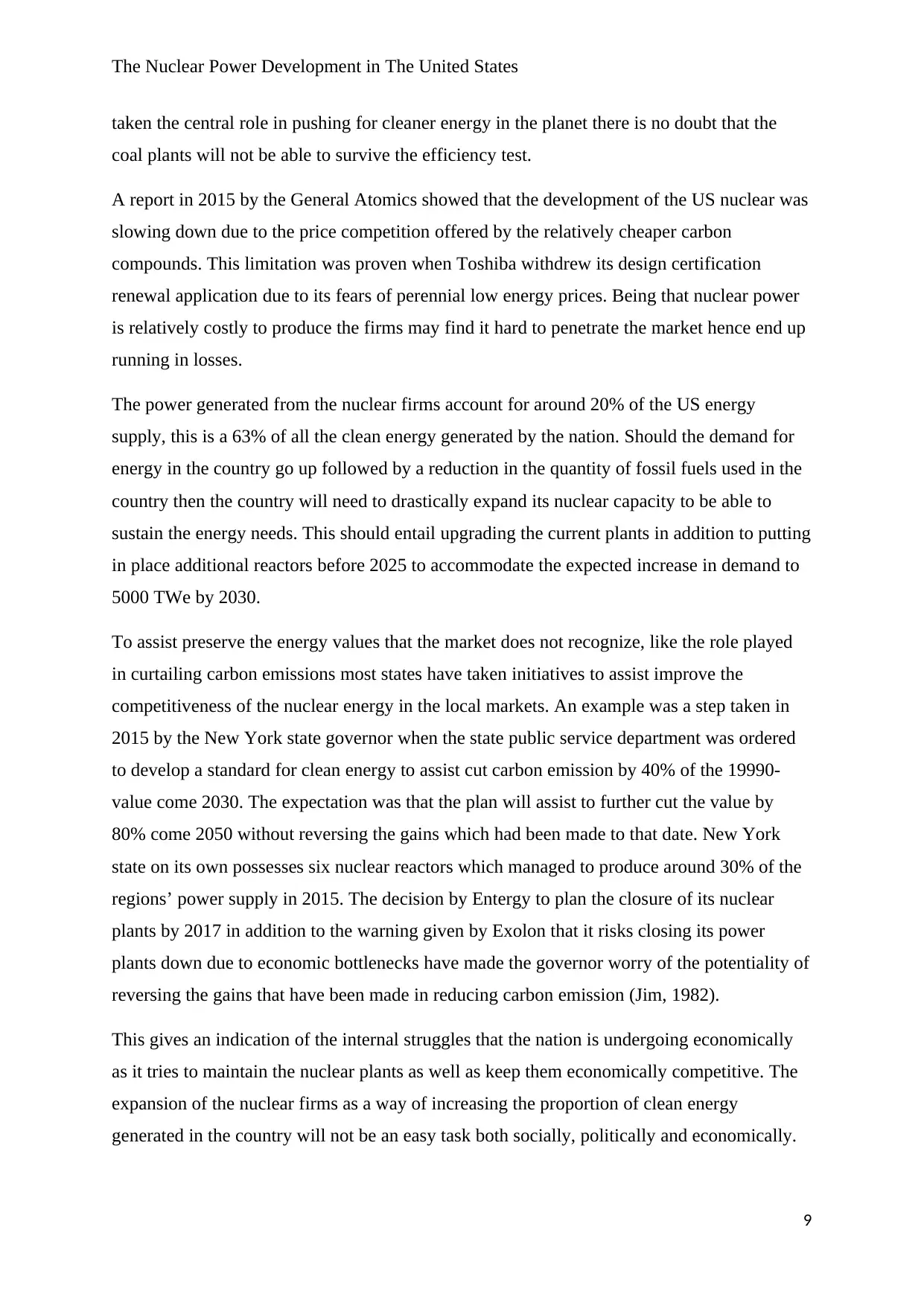
The Nuclear Power Development in The United States
taken the central role in pushing for cleaner energy in the planet there is no doubt that the
coal plants will not be able to survive the efficiency test.
A report in 2015 by the General Atomics showed that the development of the US nuclear was
slowing down due to the price competition offered by the relatively cheaper carbon
compounds. This limitation was proven when Toshiba withdrew its design certification
renewal application due to its fears of perennial low energy prices. Being that nuclear power
is relatively costly to produce the firms may find it hard to penetrate the market hence end up
running in losses.
The power generated from the nuclear firms account for around 20% of the US energy
supply, this is a 63% of all the clean energy generated by the nation. Should the demand for
energy in the country go up followed by a reduction in the quantity of fossil fuels used in the
country then the country will need to drastically expand its nuclear capacity to be able to
sustain the energy needs. This should entail upgrading the current plants in addition to putting
in place additional reactors before 2025 to accommodate the expected increase in demand to
5000 TWe by 2030.
To assist preserve the energy values that the market does not recognize, like the role played
in curtailing carbon emissions most states have taken initiatives to assist improve the
competitiveness of the nuclear energy in the local markets. An example was a step taken in
2015 by the New York state governor when the state public service department was ordered
to develop a standard for clean energy to assist cut carbon emission by 40% of the 19990-
value come 2030. The expectation was that the plan will assist to further cut the value by
80% come 2050 without reversing the gains which had been made to that date. New York
state on its own possesses six nuclear reactors which managed to produce around 30% of the
regions’ power supply in 2015. The decision by Entergy to plan the closure of its nuclear
plants by 2017 in addition to the warning given by Exolon that it risks closing its power
plants down due to economic bottlenecks have made the governor worry of the potentiality of
reversing the gains that have been made in reducing carbon emission (Jim, 1982).
This gives an indication of the internal struggles that the nation is undergoing economically
as it tries to maintain the nuclear plants as well as keep them economically competitive. The
expansion of the nuclear firms as a way of increasing the proportion of clean energy
generated in the country will not be an easy task both socially, politically and economically.
9
taken the central role in pushing for cleaner energy in the planet there is no doubt that the
coal plants will not be able to survive the efficiency test.
A report in 2015 by the General Atomics showed that the development of the US nuclear was
slowing down due to the price competition offered by the relatively cheaper carbon
compounds. This limitation was proven when Toshiba withdrew its design certification
renewal application due to its fears of perennial low energy prices. Being that nuclear power
is relatively costly to produce the firms may find it hard to penetrate the market hence end up
running in losses.
The power generated from the nuclear firms account for around 20% of the US energy
supply, this is a 63% of all the clean energy generated by the nation. Should the demand for
energy in the country go up followed by a reduction in the quantity of fossil fuels used in the
country then the country will need to drastically expand its nuclear capacity to be able to
sustain the energy needs. This should entail upgrading the current plants in addition to putting
in place additional reactors before 2025 to accommodate the expected increase in demand to
5000 TWe by 2030.
To assist preserve the energy values that the market does not recognize, like the role played
in curtailing carbon emissions most states have taken initiatives to assist improve the
competitiveness of the nuclear energy in the local markets. An example was a step taken in
2015 by the New York state governor when the state public service department was ordered
to develop a standard for clean energy to assist cut carbon emission by 40% of the 19990-
value come 2030. The expectation was that the plan will assist to further cut the value by
80% come 2050 without reversing the gains which had been made to that date. New York
state on its own possesses six nuclear reactors which managed to produce around 30% of the
regions’ power supply in 2015. The decision by Entergy to plan the closure of its nuclear
plants by 2017 in addition to the warning given by Exolon that it risks closing its power
plants down due to economic bottlenecks have made the governor worry of the potentiality of
reversing the gains that have been made in reducing carbon emission (Jim, 1982).
This gives an indication of the internal struggles that the nation is undergoing economically
as it tries to maintain the nuclear plants as well as keep them economically competitive. The
expansion of the nuclear firms as a way of increasing the proportion of clean energy
generated in the country will not be an easy task both socially, politically and economically.
9
⊘ This is a preview!⊘
Do you want full access?
Subscribe today to unlock all pages.

Trusted by 1+ million students worldwide
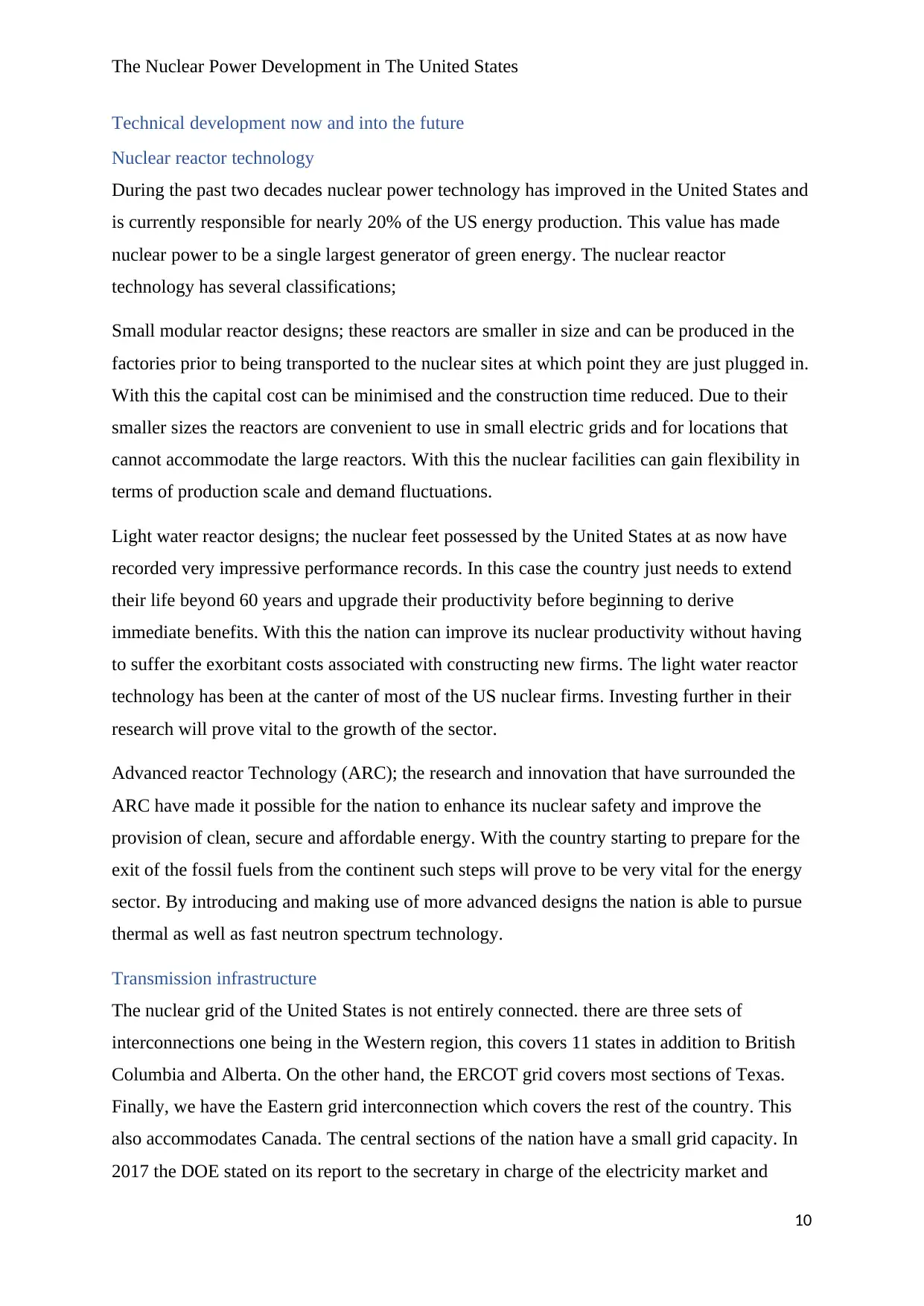
The Nuclear Power Development in The United States
Technical development now and into the future
Nuclear reactor technology
During the past two decades nuclear power technology has improved in the United States and
is currently responsible for nearly 20% of the US energy production. This value has made
nuclear power to be a single largest generator of green energy. The nuclear reactor
technology has several classifications;
Small modular reactor designs; these reactors are smaller in size and can be produced in the
factories prior to being transported to the nuclear sites at which point they are just plugged in.
With this the capital cost can be minimised and the construction time reduced. Due to their
smaller sizes the reactors are convenient to use in small electric grids and for locations that
cannot accommodate the large reactors. With this the nuclear facilities can gain flexibility in
terms of production scale and demand fluctuations.
Light water reactor designs; the nuclear feet possessed by the United States at as now have
recorded very impressive performance records. In this case the country just needs to extend
their life beyond 60 years and upgrade their productivity before beginning to derive
immediate benefits. With this the nation can improve its nuclear productivity without having
to suffer the exorbitant costs associated with constructing new firms. The light water reactor
technology has been at the canter of most of the US nuclear firms. Investing further in their
research will prove vital to the growth of the sector.
Advanced reactor Technology (ARC); the research and innovation that have surrounded the
ARC have made it possible for the nation to enhance its nuclear safety and improve the
provision of clean, secure and affordable energy. With the country starting to prepare for the
exit of the fossil fuels from the continent such steps will prove to be very vital for the energy
sector. By introducing and making use of more advanced designs the nation is able to pursue
thermal as well as fast neutron spectrum technology.
Transmission infrastructure
The nuclear grid of the United States is not entirely connected. there are three sets of
interconnections one being in the Western region, this covers 11 states in addition to British
Columbia and Alberta. On the other hand, the ERCOT grid covers most sections of Texas.
Finally, we have the Eastern grid interconnection which covers the rest of the country. This
also accommodates Canada. The central sections of the nation have a small grid capacity. In
2017 the DOE stated on its report to the secretary in charge of the electricity market and
10
Technical development now and into the future
Nuclear reactor technology
During the past two decades nuclear power technology has improved in the United States and
is currently responsible for nearly 20% of the US energy production. This value has made
nuclear power to be a single largest generator of green energy. The nuclear reactor
technology has several classifications;
Small modular reactor designs; these reactors are smaller in size and can be produced in the
factories prior to being transported to the nuclear sites at which point they are just plugged in.
With this the capital cost can be minimised and the construction time reduced. Due to their
smaller sizes the reactors are convenient to use in small electric grids and for locations that
cannot accommodate the large reactors. With this the nuclear facilities can gain flexibility in
terms of production scale and demand fluctuations.
Light water reactor designs; the nuclear feet possessed by the United States at as now have
recorded very impressive performance records. In this case the country just needs to extend
their life beyond 60 years and upgrade their productivity before beginning to derive
immediate benefits. With this the nation can improve its nuclear productivity without having
to suffer the exorbitant costs associated with constructing new firms. The light water reactor
technology has been at the canter of most of the US nuclear firms. Investing further in their
research will prove vital to the growth of the sector.
Advanced reactor Technology (ARC); the research and innovation that have surrounded the
ARC have made it possible for the nation to enhance its nuclear safety and improve the
provision of clean, secure and affordable energy. With the country starting to prepare for the
exit of the fossil fuels from the continent such steps will prove to be very vital for the energy
sector. By introducing and making use of more advanced designs the nation is able to pursue
thermal as well as fast neutron spectrum technology.
Transmission infrastructure
The nuclear grid of the United States is not entirely connected. there are three sets of
interconnections one being in the Western region, this covers 11 states in addition to British
Columbia and Alberta. On the other hand, the ERCOT grid covers most sections of Texas.
Finally, we have the Eastern grid interconnection which covers the rest of the country. This
also accommodates Canada. The central sections of the nation have a small grid capacity. In
2017 the DOE stated on its report to the secretary in charge of the electricity market and
10
Paraphrase This Document
Need a fresh take? Get an instant paraphrase of this document with our AI Paraphraser
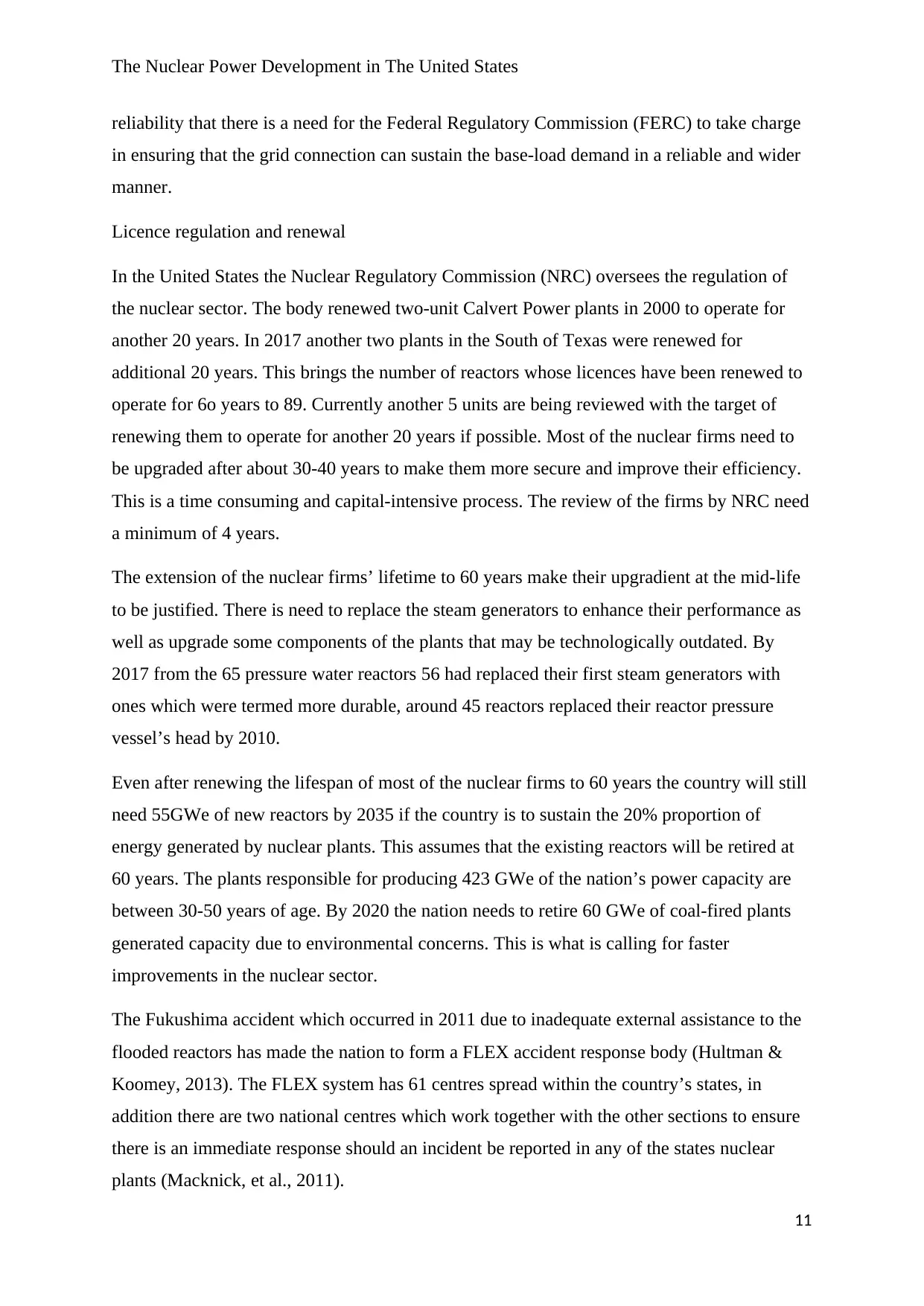
The Nuclear Power Development in The United States
reliability that there is a need for the Federal Regulatory Commission (FERC) to take charge
in ensuring that the grid connection can sustain the base-load demand in a reliable and wider
manner.
Licence regulation and renewal
In the United States the Nuclear Regulatory Commission (NRC) oversees the regulation of
the nuclear sector. The body renewed two-unit Calvert Power plants in 2000 to operate for
another 20 years. In 2017 another two plants in the South of Texas were renewed for
additional 20 years. This brings the number of reactors whose licences have been renewed to
operate for 6o years to 89. Currently another 5 units are being reviewed with the target of
renewing them to operate for another 20 years if possible. Most of the nuclear firms need to
be upgraded after about 30-40 years to make them more secure and improve their efficiency.
This is a time consuming and capital-intensive process. The review of the firms by NRC need
a minimum of 4 years.
The extension of the nuclear firms’ lifetime to 60 years make their upgradient at the mid-life
to be justified. There is need to replace the steam generators to enhance their performance as
well as upgrade some components of the plants that may be technologically outdated. By
2017 from the 65 pressure water reactors 56 had replaced their first steam generators with
ones which were termed more durable, around 45 reactors replaced their reactor pressure
vessel’s head by 2010.
Even after renewing the lifespan of most of the nuclear firms to 60 years the country will still
need 55GWe of new reactors by 2035 if the country is to sustain the 20% proportion of
energy generated by nuclear plants. This assumes that the existing reactors will be retired at
60 years. The plants responsible for producing 423 GWe of the nation’s power capacity are
between 30-50 years of age. By 2020 the nation needs to retire 60 GWe of coal-fired plants
generated capacity due to environmental concerns. This is what is calling for faster
improvements in the nuclear sector.
The Fukushima accident which occurred in 2011 due to inadequate external assistance to the
flooded reactors has made the nation to form a FLEX accident response body (Hultman &
Koomey, 2013). The FLEX system has 61 centres spread within the country’s states, in
addition there are two national centres which work together with the other sections to ensure
there is an immediate response should an incident be reported in any of the states nuclear
plants (Macknick, et al., 2011).
11
reliability that there is a need for the Federal Regulatory Commission (FERC) to take charge
in ensuring that the grid connection can sustain the base-load demand in a reliable and wider
manner.
Licence regulation and renewal
In the United States the Nuclear Regulatory Commission (NRC) oversees the regulation of
the nuclear sector. The body renewed two-unit Calvert Power plants in 2000 to operate for
another 20 years. In 2017 another two plants in the South of Texas were renewed for
additional 20 years. This brings the number of reactors whose licences have been renewed to
operate for 6o years to 89. Currently another 5 units are being reviewed with the target of
renewing them to operate for another 20 years if possible. Most of the nuclear firms need to
be upgraded after about 30-40 years to make them more secure and improve their efficiency.
This is a time consuming and capital-intensive process. The review of the firms by NRC need
a minimum of 4 years.
The extension of the nuclear firms’ lifetime to 60 years make their upgradient at the mid-life
to be justified. There is need to replace the steam generators to enhance their performance as
well as upgrade some components of the plants that may be technologically outdated. By
2017 from the 65 pressure water reactors 56 had replaced their first steam generators with
ones which were termed more durable, around 45 reactors replaced their reactor pressure
vessel’s head by 2010.
Even after renewing the lifespan of most of the nuclear firms to 60 years the country will still
need 55GWe of new reactors by 2035 if the country is to sustain the 20% proportion of
energy generated by nuclear plants. This assumes that the existing reactors will be retired at
60 years. The plants responsible for producing 423 GWe of the nation’s power capacity are
between 30-50 years of age. By 2020 the nation needs to retire 60 GWe of coal-fired plants
generated capacity due to environmental concerns. This is what is calling for faster
improvements in the nuclear sector.
The Fukushima accident which occurred in 2011 due to inadequate external assistance to the
flooded reactors has made the nation to form a FLEX accident response body (Hultman &
Koomey, 2013). The FLEX system has 61 centres spread within the country’s states, in
addition there are two national centres which work together with the other sections to ensure
there is an immediate response should an incident be reported in any of the states nuclear
plants (Macknick, et al., 2011).
11
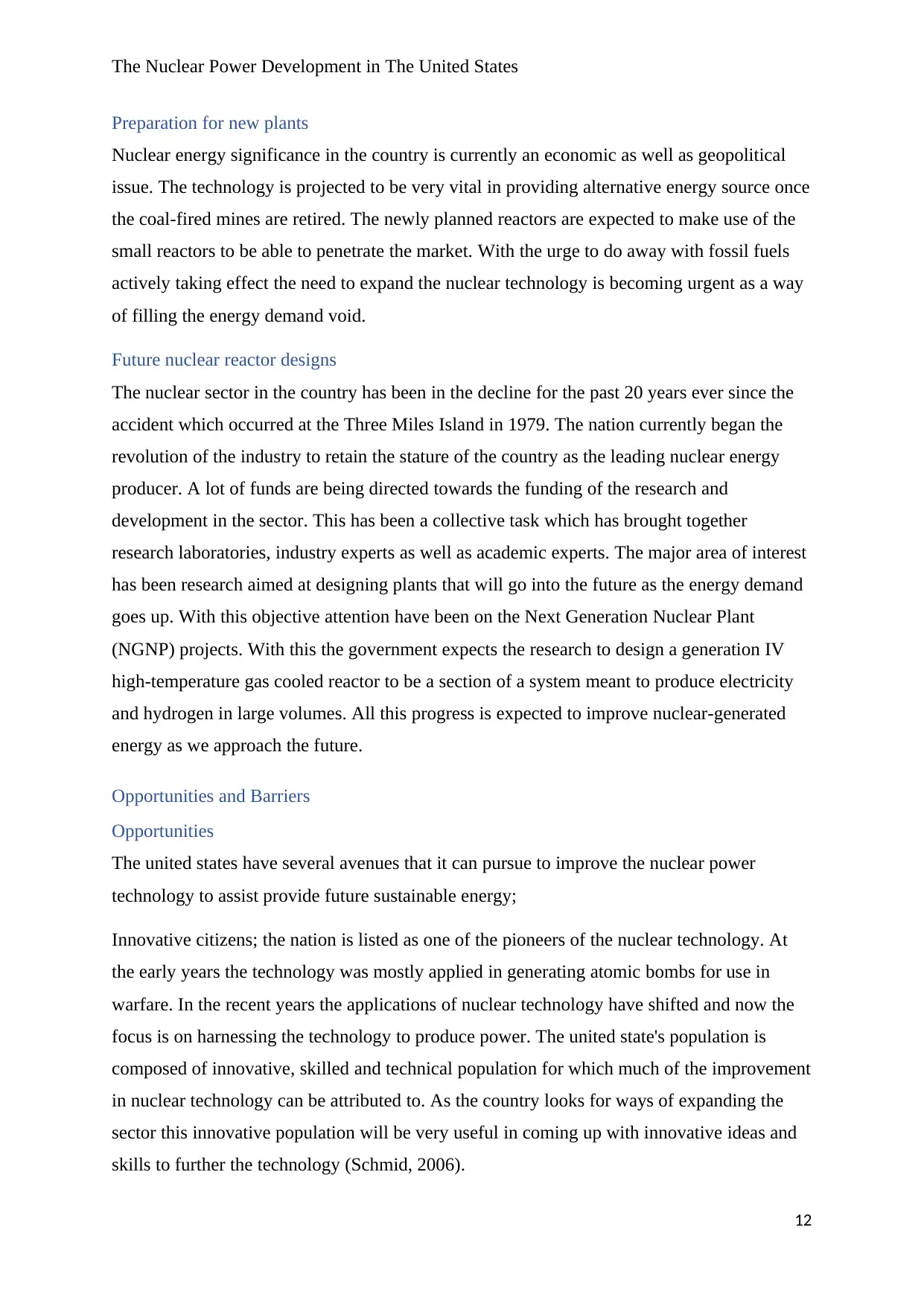
The Nuclear Power Development in The United States
Preparation for new plants
Nuclear energy significance in the country is currently an economic as well as geopolitical
issue. The technology is projected to be very vital in providing alternative energy source once
the coal-fired mines are retired. The newly planned reactors are expected to make use of the
small reactors to be able to penetrate the market. With the urge to do away with fossil fuels
actively taking effect the need to expand the nuclear technology is becoming urgent as a way
of filling the energy demand void.
Future nuclear reactor designs
The nuclear sector in the country has been in the decline for the past 20 years ever since the
accident which occurred at the Three Miles Island in 1979. The nation currently began the
revolution of the industry to retain the stature of the country as the leading nuclear energy
producer. A lot of funds are being directed towards the funding of the research and
development in the sector. This has been a collective task which has brought together
research laboratories, industry experts as well as academic experts. The major area of interest
has been research aimed at designing plants that will go into the future as the energy demand
goes up. With this objective attention have been on the Next Generation Nuclear Plant
(NGNP) projects. With this the government expects the research to design a generation IV
high-temperature gas cooled reactor to be a section of a system meant to produce electricity
and hydrogen in large volumes. All this progress is expected to improve nuclear-generated
energy as we approach the future.
Opportunities and Barriers
Opportunities
The united states have several avenues that it can pursue to improve the nuclear power
technology to assist provide future sustainable energy;
Innovative citizens; the nation is listed as one of the pioneers of the nuclear technology. At
the early years the technology was mostly applied in generating atomic bombs for use in
warfare. In the recent years the applications of nuclear technology have shifted and now the
focus is on harnessing the technology to produce power. The united state's population is
composed of innovative, skilled and technical population for which much of the improvement
in nuclear technology can be attributed to. As the country looks for ways of expanding the
sector this innovative population will be very useful in coming up with innovative ideas and
skills to further the technology (Schmid, 2006).
12
Preparation for new plants
Nuclear energy significance in the country is currently an economic as well as geopolitical
issue. The technology is projected to be very vital in providing alternative energy source once
the coal-fired mines are retired. The newly planned reactors are expected to make use of the
small reactors to be able to penetrate the market. With the urge to do away with fossil fuels
actively taking effect the need to expand the nuclear technology is becoming urgent as a way
of filling the energy demand void.
Future nuclear reactor designs
The nuclear sector in the country has been in the decline for the past 20 years ever since the
accident which occurred at the Three Miles Island in 1979. The nation currently began the
revolution of the industry to retain the stature of the country as the leading nuclear energy
producer. A lot of funds are being directed towards the funding of the research and
development in the sector. This has been a collective task which has brought together
research laboratories, industry experts as well as academic experts. The major area of interest
has been research aimed at designing plants that will go into the future as the energy demand
goes up. With this objective attention have been on the Next Generation Nuclear Plant
(NGNP) projects. With this the government expects the research to design a generation IV
high-temperature gas cooled reactor to be a section of a system meant to produce electricity
and hydrogen in large volumes. All this progress is expected to improve nuclear-generated
energy as we approach the future.
Opportunities and Barriers
Opportunities
The united states have several avenues that it can pursue to improve the nuclear power
technology to assist provide future sustainable energy;
Innovative citizens; the nation is listed as one of the pioneers of the nuclear technology. At
the early years the technology was mostly applied in generating atomic bombs for use in
warfare. In the recent years the applications of nuclear technology have shifted and now the
focus is on harnessing the technology to produce power. The united state's population is
composed of innovative, skilled and technical population for which much of the improvement
in nuclear technology can be attributed to. As the country looks for ways of expanding the
sector this innovative population will be very useful in coming up with innovative ideas and
skills to further the technology (Schmid, 2006).
12
⊘ This is a preview!⊘
Do you want full access?
Subscribe today to unlock all pages.

Trusted by 1+ million students worldwide
1 out of 19
Related Documents
Your All-in-One AI-Powered Toolkit for Academic Success.
+13062052269
info@desklib.com
Available 24*7 on WhatsApp / Email
![[object Object]](/_next/static/media/star-bottom.7253800d.svg)
Unlock your academic potential
Copyright © 2020–2025 A2Z Services. All Rights Reserved. Developed and managed by ZUCOL.





